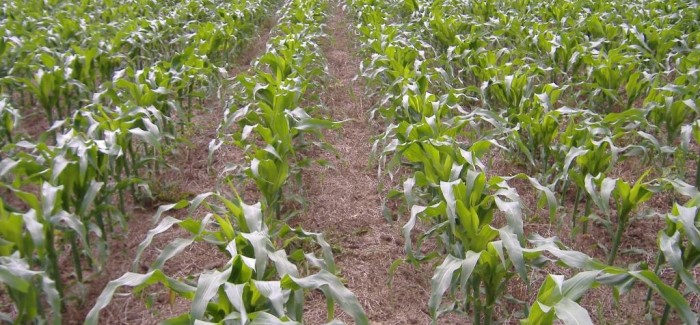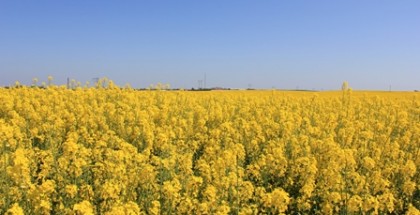Group 1 herbicide: Centurion
Centurion- emulsifiable concentrate post-emergence herbicide, Group 1 herbicide.
CENTURION is a selective post-emergence herbicide for control of a broad range of grasses in canola, flax (including low linolenic acid varieties), field peas, lentils, Desi and Kabuli chickpeas, dry onions, potatoes, yellow mustard, oriental (brown) mustard (condiment and oilseed types), soybeans, seedling alfalfa, sunflowers, dry common beans (Phaseolus vulgaris varieties only), fenugreek, coriander, spinach, prairie carnation, highbush blueberry, safflower and cranberry.
CENTURION is to be used only with the adjuvant AMIGO.
CENTURION is a systemic herbicide which is translocated from the treated foliage to the growing points of the leaves, shoots and roots. Uptake into the plant is primarily through its leaves.
ENVIRONMENTAL HAZARDS:
TOXIC to non-target terrestrial plants. Observe buffer zones specific under DIRECTIONS FOR USE.
Avoid spray drift. Avoid contamination of ponds, streams, rivers and desirable vegetation. This product contains a petroleum distillate which is moderately to highly toxic to aquatic organisms. Avoid contamination of aquatic systems during application. Do not contaminate these systems through direct application, disposal of waste or cleaning of equipment.
Thorough coverage of the foliage is important for consistent grass control. Susceptible grasses that are actively growing will undergo a burn-back and colour change after treatment. Leaf foliage will first change from green to yellowish, then purplish and finally brown colour. The time required for complete control is normally 7 to 21 days following treatment, depending on growing conditions and crop competition.
TOXICOLOGICAL INFORMATION: Treat symptomatically. This product contains petroleum distillates. Vomiting may cause aspiration pneumonia. Danger from lung aspiration of petroleum based solvents must be weighed against toxicity when considering emptying stomach.
STORAGE AND DISPOSAL
STORAGE: May be stored at any temperature. SHAKE WELL BEFORE USING. Insecticides and fungicides should be segregated from herbicides so as to prevent the possibility of cross-contamination.
DIRECTIONS FOR USE:
TIME OF APPLICATION:
Apply CENTURION when the annual grasses and volunteer cereals are in the 2 to 6 leaf stage as specified under Application Rates of CENTURION. Most effective control is, achieved when application is made prior to tillering when annual grasses are small and actively growing. For suppression or control of quackgrass, apply CENTURION when the quackgrass is in the 2 to 6 leaf stage and 6 to 15 cm in height. Most effective results are achieved when application is made at the 3 to 5 leaf stage, when the canopy is uniform and actively growing.
CENTURION will be less effective when plants are stressed by lack of moisture, excessive moisture, low-temperature and/or very low relative humidity. Regrowth by tillering may occur if application is made under any of the above stress conditions. In wide row crops, where the canopy may be slow to close, cultivation may be necessary to control grasses that emerge after treatment.
Canola, flax (including low linolenic acid varieties), field peas, lentils, Desi and Kabuli chickpeas, dry onions, potatoes, yellow mustard, oriental (brown) mustard (condiment and oilseed types), soybeans, seedling alfalfa, sunflowers, dry common beans (Phaseolus vulgaris varieties only) and highbush blueberry are tolerant to CENTURIONat all stages of growth. However, the pre-harvest interval outlined in the Crop Recommendations table must be followed to avoid excessive crop residues.
For Desi and Kabuli chickpeas, apply CENTURION at a maximum of one application per season before the crop reaches the 9 node stage (18 cm height maximum) and when the annual grasses and volunteer cereals are in the 2 to 6 leaf stage. For fenugreek, apply CENTURION post-emergence, when fenugreek is in the 3 – 5 leaf stage at a maximum of one application per season. For coriander, apply CENTURION post-emergence, when coriander is in the 2 – 5 leaf stage at a maximum of one application per season.
For safflower, apply CENTURION post-emergence, when safflower is in the 6-8 leaf stage. Cranberry is tolerant to CENTURION at all stages of growth, however do not apply CENTURION between the hook stage and full fruit set.
HERBICIDE RESISTANCE MANAGEMENT RECOMMENDATIONS:
For resistance management, CENTURION is a Group 1 herbicide. Any weed population may contain or develop plants naturally resistant to CENTURION and other Group 1 herbicides. The resistant biotypes may dominate the weed population if these herbicides are used repeatedly in the same field. Other resistance mechanisms that are not linked to site of action, but specific for individual chemicals, such as enhanced metabolism, may also exist. Appropriate resistance-management strategies should be followed. To delay herbicide resistance:
Where possible, rotate the use of CENTURION or other Group 1 herbicides with different herbicide groups that control the same weeds in a field.
Use tank mixtures with herbicides from a different group when such use is permitted.
Herbicide use should be based on an IPM program that includes scouting, historical information related to herbicide use and crop rotation, and considers tillage (or other mechanical), cultural, biological and other chemical control practices.
Monitor treated weed populations for resistance development.
Prevent movement of resistant weed seeds to other fields by cleaning harvesting and tillage equipment and planting clean seed.
Contact your local extension specialist or certified crop advisors for any additional pesticide resistance-management and/or integrated weed-management recommendations for specific crops and weed biotypes.
(Source – http://www.bayercropscience.ca/English/LabelMSDS/510/File.ashx)


















Submit a Comment